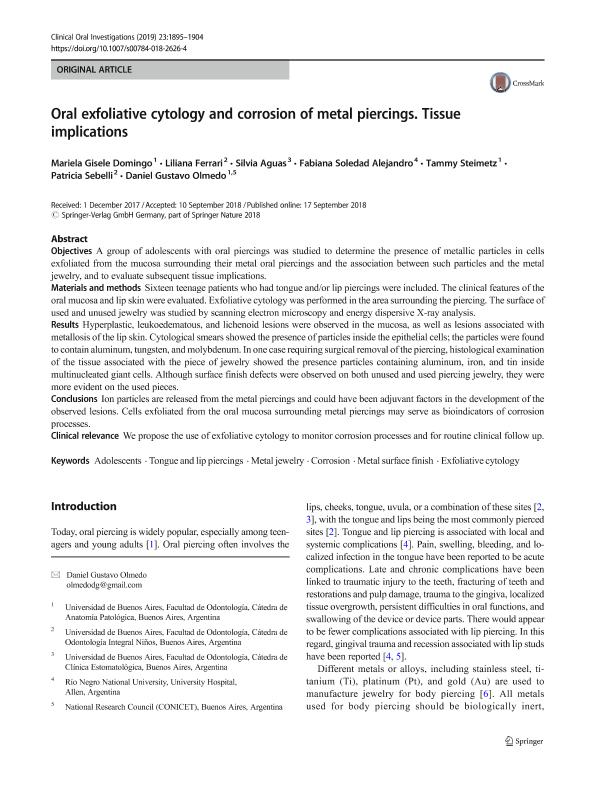Mostrar el registro sencillo del ítem
dc.contributor.author
Domingo, Mariela Gisele

dc.contributor.author
Ferrari, Liliana
dc.contributor.author
Aguas, Silvia
dc.contributor.author
Alejandro, Fabiana Soledad
dc.contributor.author
Steimetz, Tammy

dc.contributor.author
Sebelli, Patricia
dc.contributor.author
Olmedo, Daniel Gustavo

dc.date.available
2021-03-03T14:55:02Z
dc.date.issued
2019-04
dc.identifier.citation
Domingo, Mariela Gisele; Ferrari, Liliana; Aguas, Silvia; Alejandro, Fabiana Soledad; Steimetz, Tammy; et al.; Oral exfoliative cytology and corrosion of metal piercings: Tissue implications; Springer Heidelberg; Clinical Oral Investigations.; 23; 4; 4-2019; 1895-1904
dc.identifier.issn
1432-6981
dc.identifier.uri
http://hdl.handle.net/11336/127290
dc.description.abstract
Objectives: A group of adolescents with oral piercings was studied to determine the presence of metallic particles in cells exfoliated from the mucosa surrounding their metal oral piercings and the association between such particles and the metal jewelry, and to evaluate subsequent tissue implications. Materials and methods: Sixteen teenage patients who had tongue and/or lip piercings were included. The clinical features of the oral mucosa and lip skin were evaluated. Exfoliative cytology was performed in the area surrounding the piercing. The surface of used and unused jewelry was studied by scanning electron microscopy and energy dispersive X-ray analysis. Results: Hyperplastic, leukoedematous, and lichenoid lesions were observed in the mucosa, as well as lesions associated with metallosis of the lip skin. Cytological smears showed the presence of particles inside the epithelial cells; the particles were found to contain aluminum, tungsten, and molybdenum. In one case requiring surgical removal of the piercing, histological examination of the tissue associated with the piece of jewelry showed the presence particles containing aluminum, iron, and tin inside multinucleated giant cells. Although surface finish defects were observed on both unused and used piercing jewelry, they were more evident on the used pieces. Conclusions: Ion particles are released from the metal piercings and could have been adjuvant factors in the development of the observed lesions. Cells exfoliated from the oral mucosa surrounding metal piercings may serve as bioindicators of corrosion processes. Clinical relevance: We propose the use of exfoliative cytology to monitor corrosion processes and for routine clinical follow up.
dc.format
application/pdf
dc.language.iso
eng
dc.publisher
Springer Heidelberg

dc.rights
info:eu-repo/semantics/openAccess
dc.rights.uri
https://creativecommons.org/licenses/by-nc-sa/2.5/ar/
dc.subject
ADOLESCENTS
dc.subject
CORROSION
dc.subject
EXFOLIATIVE CYTOLOGY
dc.subject
METAL JEWELRY
dc.subject
METAL SURFACE FINISH
dc.subject
TONGUE AND LIP PIERCINGS
dc.subject.classification
Otras Ciencias de la Salud

dc.subject.classification
Ciencias de la Salud

dc.subject.classification
CIENCIAS MÉDICAS Y DE LA SALUD

dc.title
Oral exfoliative cytology and corrosion of metal piercings: Tissue implications
dc.type
info:eu-repo/semantics/article
dc.type
info:ar-repo/semantics/artículo
dc.type
info:eu-repo/semantics/publishedVersion
dc.date.updated
2021-01-27T19:13:20Z
dc.journal.volume
23
dc.journal.number
4
dc.journal.pagination
1895-1904
dc.journal.pais
Alemania

dc.journal.ciudad
Heidelberg
dc.description.fil
Fil: Domingo, Mariela Gisele. Universidad de Buenos Aires. Facultad de Odontología. Cátedra de Anatomía Patológica; Argentina
dc.description.fil
Fil: Ferrari, Liliana. Universidad de Buenos Aires. Facultad de Odontología; Argentina
dc.description.fil
Fil: Aguas, Silvia. Cátedra de Clínica Estomatológica ; Facultad de Odontologia ; Universidad de Buenos Aires;
dc.description.fil
Fil: Alejandro, Fabiana Soledad. Universidad Nacional de Río Negro. Sede Alto Valle; Argentina
dc.description.fil
Fil: Steimetz, Tammy. Consejo Nacional de Investigaciones Científicas y Técnicas. Oficina de Coordinación Administrativa Houssay; Argentina. Universidad de Buenos Aires. Facultad de Odontología. Cátedra de Anatomía Patológica; Argentina
dc.description.fil
Fil: Sebelli, Patricia. Universidad de Buenos Aires. Facultad de Odontología; Argentina
dc.description.fil
Fil: Olmedo, Daniel Gustavo. Universidad de Buenos Aires. Facultad de Odontología. Cátedra de Anatomía Patológica; Argentina. Consejo Nacional de Investigaciones Científicas y Técnicas. Oficina de Coordinación Administrativa Houssay; Argentina
dc.journal.title
Clinical Oral Investigations.

dc.relation.alternativeid
info:eu-repo/semantics/altIdentifier/url/https://link.springer.com/article/10.1007%2Fs00784-018-2626-4
dc.relation.alternativeid
info:eu-repo/semantics/altIdentifier/doi/http://dx.doi.org/10.1007/s00784-018-2626-4
Archivos asociados
